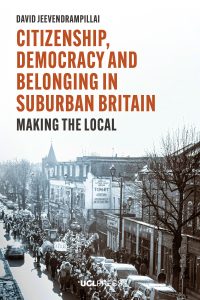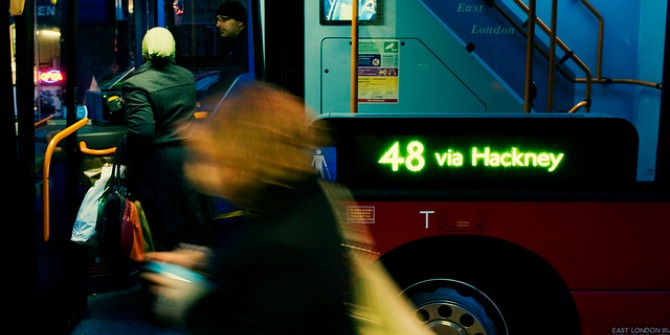In Citizenship, Democracy, and Belonging in Suburban Britain: Making the Local – available open access from UCL Press – David Jeevendrampillai explores how inclusiveness and citizen participation can create resilient and welcoming communities, drawing on his ethnographic study of the London suburb of Surbiton. This book will benefit those working in any capacity with the built environment and its citizens, including urbanists and planners, writes Jade Orr.
Citizenship, Democracy, and Belonging in Suburban Britain: Making the Local. David Jeevendrampillai. UCL Press. 2021.
 At a time of increasing social isolation and turmoil, David Jeevendrampillai’s Citizenship, Democracy, and Belonging in Suburban Britain hits close to home and feels like a necessary endeavour as it enlightens readers to the ways in which inclusiveness and citizen participation could create resilient and welcoming communities in unexpected ways.
At a time of increasing social isolation and turmoil, David Jeevendrampillai’s Citizenship, Democracy, and Belonging in Suburban Britain hits close to home and feels like a necessary endeavour as it enlightens readers to the ways in which inclusiveness and citizen participation could create resilient and welcoming communities in unexpected ways.
A resilient community can be defined as an adaptable community that is able to resist and recover from adverse social conditions or scenarios, utilising available resources and community networks. While often thought of in relation to environmental challenges, community resilience also applies to social and economic threats brought about by unchecked development, gentrification and neighbourhood decline.
Throughout his book, Jeevendrampillai engages with two social projects to investigate what it means to be an active citizen and how this relates to notions of inclusivity, democracy and belonging. An active citizen, in the view of Jeevendrampillai, is one that engages meaningfully with their community, whether through participation in local events, political activism or community engagement, forming the ties necessary to create a resilient community. He explores these ideas further by undertaking a long-term ethnographic study of the London suburb of Surbiton.
The first project Jeevendrampillai participated in as their hired anthropologist was the Adaptable Suburbs Project (ASP), spearheaded by the School of Architecture at University College London. The ASP aimed to evaluate the dynamics of suburbs, which are often overlooked in favour of their urban counterparts, to determine what they had to offer in terms of their long-term adaptability and resilience. To do this, the ASP examined the ways that social and economic activity are affected by and interact with social and physical change over time. By studying several suburbs, including Surbiton, the ASP sought to better understand the inner workings of these environments and their social value. The ASP aimed to develop targeted policy suggestions designed to improve conditions in London suburbs and elevate their status as their own entities rather than just bedroom communities to larger cities.
Through Jeevendrampillai’s work with the ASP, he became deeply entrenched in a second project run by community activists from Surbiton, named the ‘Seethingers’ and representing a group of locally engaged citizens, as he undertook his ethnographic study of Surbiton alongside them. The Seethingers were mostly white, middle- to upper-class residents, who aimed to form an inclusive, resilient community that could resist the neoliberal forces of development and social isolation creeping into their suburban haven. The Seethingers, through their communal organisation, were responding to what they perceived to be increasing social seclusion, the devaluation of Surbiton to merely a peripheral commuter town and the threats of rampant development emanating from the city. More broadly, the Seethingers were responding to the fear of a loss of community.

Image Credit: ‘Surbiton Railway Station, Surbiton, UK’ by Ok2010 licensed under CC BY SA 3.0
Representative of these broader threats and the Seethingers’ response, Jeevendrampillai highlights a specific instance in which the group had to confront local government in order to mount a campaign to save a historic site within Surbiton. The site housed historic waterworks and reservoirs that had great significance both as a source of community pride and also as the site where Dr John Snow was able to discover the cause of cholera and put an end to the outbreak in the nineteenth century. This landmark was being threatened by a proposal to build a development of luxury apartments that the Seethingers thought would not only destroy this important historic site, but also fundamentally change the character of Surbiton.
With this impending threat to Surbiton in mind, Jeevendrampillai focused on the informal approach the Seethingers took to building an inclusive, resilient community in a suburban environment in contrast to the ASP’s academic, data-based approach.
Even though the ASP and the Seethingers were both seeking answers to the question of what characteristics and underlying forces impacted the resilience and adaptability of the suburban community, they took very different approaches. As the ASP was a university group comprised of a team of academic researchers, they focused more on formulaic analysis that drew on theoretical frameworks and methodologies adopted from a variety of disciplines, including architecture, anthropology, history and geography, in order to form a dataset. This dataset allowed them to interpret the spatial relations of social and economic factors within suburbs in order to make a better, stronger community.
By contrast, the Seethingers adopted a more informal approach to community and frequently used playful stories and what they referred to as ‘stupid events’ to engender a sense of inclusion and egalitarianism among their group members. While the ASP dealt with complex, calculable data, the Seethingers purposefully committed to not focusing on ‘true fact’; rather, they undertook play in order to prevent exclusion within the group based on discrepancies in formal knowledge.
Jeevendrampillai provides insight into the ways in which, although at times silly, the Seethingers focused on what he calls ‘horizontal citizenship’ that created a more equitable community. One way they sought to do this was by participating in what they proclaimed to be ‘stupid events’ which they used to unify their group and interact with the surrounding community. These ranged from a ‘Freshwater Sardine Festival’ to community craft days in preparation for parades celebrating characters from local lore. Though the Seethingers described the ‘stupid events’ as simply a way to bring their group together and engage in playful interactions, these worked to challenge traditional, isolating perceptions of suburban life and project their ideal version of suburbia that was built on trust, community and inclusion.
By expounding upon the differences between the approaches of the ASP and the Seethingers, the book enlightens readers to both the strengths and weaknesses of each. Coming back to the threat of the luxury development that would have overtaken the Seethingers’ beloved historic site in Surbiton, Jeevendrampillai highlights the successes of the Seethingers’ strategy for creating a resilient community. Because of their use of play and ‘stupid events’, the Seethingers formed a strong bond among the group, learning each other’s strengths and weaknesses and what they each had to contribute to the campaign to save the site. Additionally, their events within the community helped cultivate individual feelings of meaningful connection to Surbiton within the suburban locale.
In the end, the Seethingers were triumphant in their campaign against the luxury development. While they were working on a distinctly local scale, their strategies of community-building have lessons of best practice for other communities outside of Surbiton. While the ASP’s objectivity and expertise allowed them to work on a broader scale, helping to shape future policy for urban development, their findings supported the Seethingers’ belief that the suburb is a place of importance for the community and that it is necessary to see the suburb as an entity in its own right rather than just a commuter town serving the larger city.
The approaches of the Seethingers and the ASP both inform different ways necessary for thinking about community and inclusion. While the fine-detailed analytical approach of the ASP provided opportunities for scalability and objectivity in influencing larger urban development policy, it was the more nuanced, community-based approach of the Seethingers that helped uncover some of the significant social value laden in the social fabric of the suburbs.
Each way of knowing and understanding that Jeevendrampillai brings to light enables new ways of recognising and questioning the dynamics at play in the creation of a successful community. These findings will benefit those working in any capacity with the built environment or its citizens. This book will be useful for a multiplicity of practitioners working across disciplines, including urbanists, planners and anyone engaging with what it takes to shape a resilient community.
Note: This review gives the views of the author, and not the position of the LSE Review of Books blog, or of the London School of Economics and Political Science.







